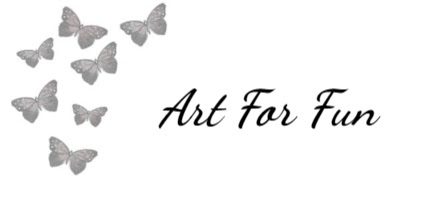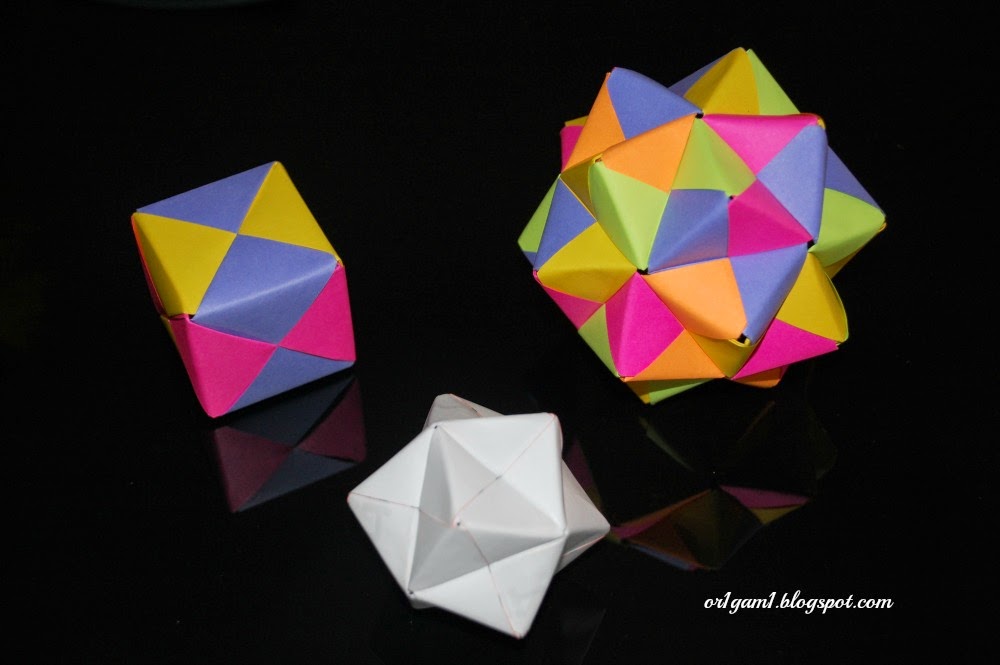Above Photo : Sonobe Cube, Sonobe Octahedron and Sonobe Icosahedron
I am writing this article referring to wiki definition of Sonobe (
http://en.wikipedia.org/wiki/Sonobe), borrowing facts and the below table from wiki to note down some points for my quick reference.
The creator of Sonobe is Mitsunobu Sonobe. A single sonobe unit looks like a parallelogram with 135 and 45 degrees angle. Three of such Sonobe units forms a triangular pyramid (open bottomed). In geometry placing such triangular pyramids on each of the four triangular faces of a tetrahedron we get a cube. Similarly by placing triangular pyramids on octahedron and icosahedron results in augmented octahedron (Sonobe Octahedron) and augmented icosahedron (Sonobe Icosahedron).
Since the triangular pyramid we obtain by joining 3 Sonobe unit is open bottomed, the underlying polyhedra (tetrahedron/octahedron/icosahedron) is imaginary. Sonobe units is only for the pyramids.
The word Augmented in geometry means that a pyramid has been joined to a face of the solid in question. Here the solid in question is octahedron and icosahedron (or tetrahedron). We are joining triangular pyramid on it's faces. Hence we say augmented Octahedron and augmented icosahedon.
|
| s | 2s | 3s | s + 2 |
| 6 | 12 | 18 | 8 |
| 12 | 24 | 36 | 14 |
| 30 | 60 | 90 | 32 |
The above table is for Sonobe : Cube (s = 6), Octahedron (s = 12) and Icosahedron (s = 30)
To explain the above table consider example of Sonobe Cube, we need 6 Sonobe units to make a Cube.
Faces (applying formula) 2 * 6 = 12
(Note : It's a triangular face - not to be confused with face of cube. As a matter of fact One face of Cube has 2 faces of Sonobe Cube)
Logic : A pyramid that we place on the face of tetrahedron has 3 triangular faces. We need 4 pyramids to make a cube. Hence 3 * 4 = 12
Edges (applying formula) 3 * 6 = 18
Logic : Edges of tetrahedron + 3 * (number of pyramids) = 6 + (3 * 4) = 18
Vertices (applying formula) 6 + 2 = 8
Logic : Vertices of tetrahedron + apex of pyramids (equal to number of faces of tetrahedron) = 4 + 4 = 8
Same logic can be applied for Augmented octahedron and Augmented icosahedron. It might be little confusing to visualize the above logic with the Sonobe cube since the pyramids are not protruding. The below video might help visualizing.
Basically a cube can be divided into five tetrahedra - if a cube is triangulated such that the central tetrahedron is regular. A tetrahedron is a triangular pyramid.
Reference:
http://www.ics.uci.edu/~eppstein/projects/tetra/
Above Photo : Sonobe Octahedron
Sonobe Octahedron (Augmented Octahedron) might help in better understanding.
Tetrahedron, Octahedron and Icosahedron are
Platonic Solids. Cube and Dodecahedron are the other Platonic Solids. A cube has square faces, Dodecahedron has pentagonal faces - hence triangular pyramids cannot be placed.
Augmented Icosahedron / Sonobe Icosahedron is widely folded in Origami to obtain attractive floral balls. A Sonobe Icosahedron has 20 pyramids because Icosahedron has 20 (triangular) faces. Similarly a Sonobe Octahedron has 8 pyramids because Octahedron has 8 (triangular) faces and Sonobe Cube has 4 pyramids because tetrahedron has 4 (triangular) faces.
Note: I have used Sonobe Icosahedron and Augmented Icosahedron names interchangeably (Similarly Sonobe Octahedron and Augmented Octahedron).








